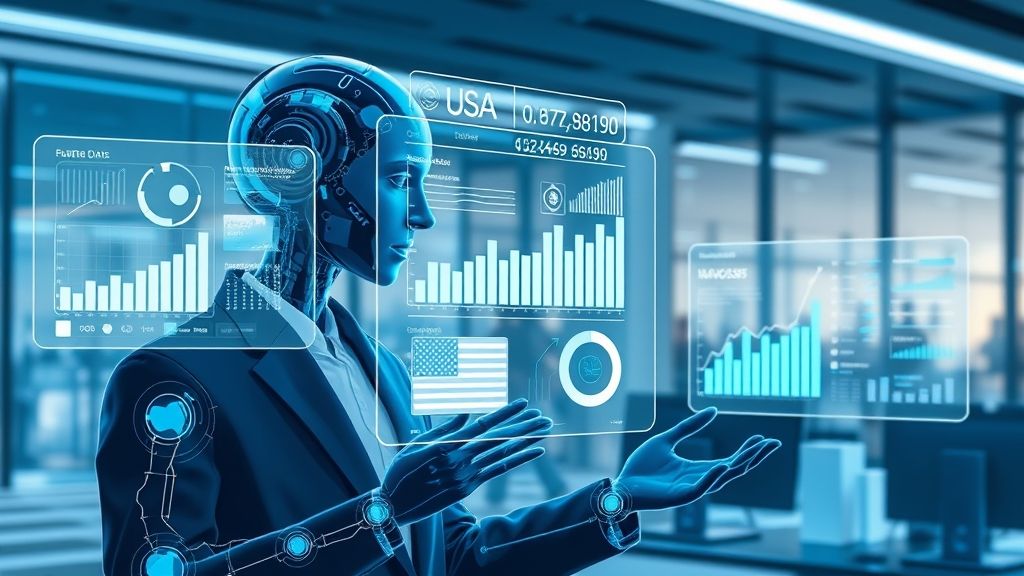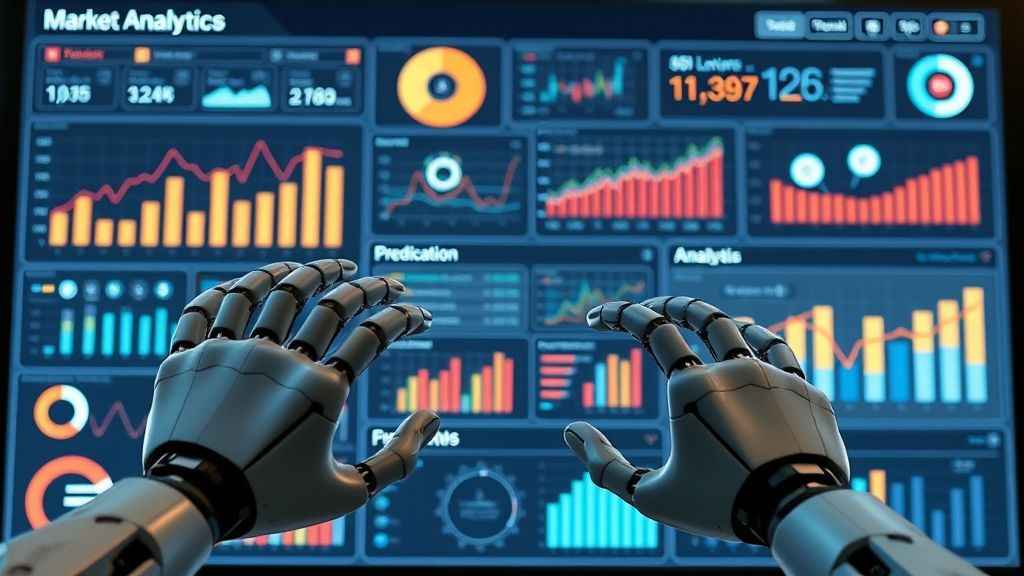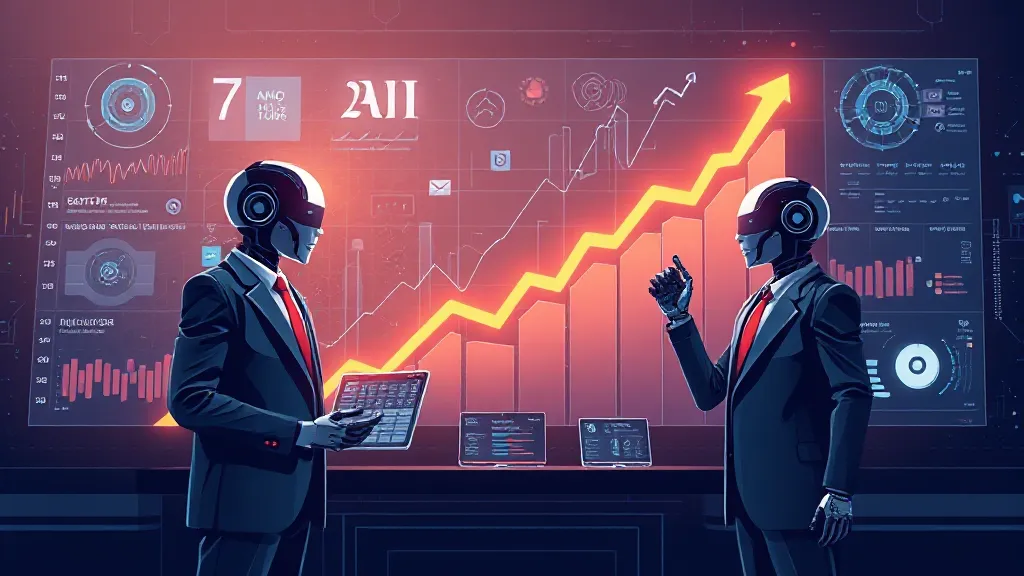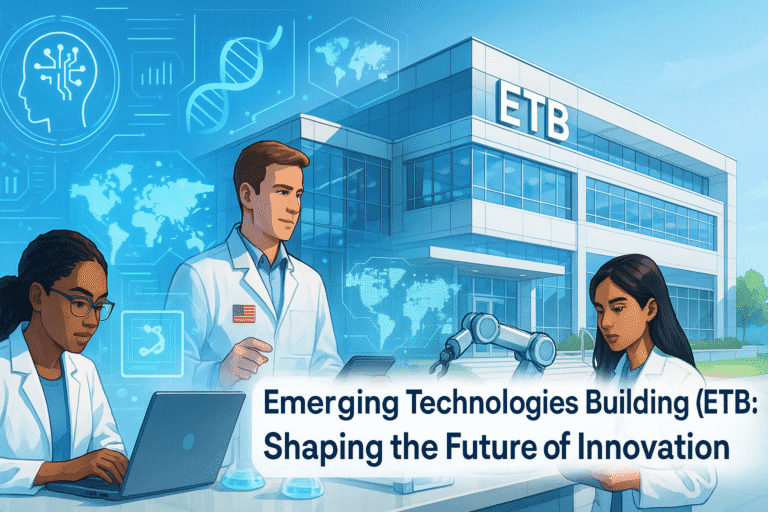AI for market research refers to using artificial intelligence and machine learning technologies to gather, analyze, and interpret market data. In the United States – where the market research industry was valued at over $24 billion in 2024 (prismetric.com) – AI is revolutionizing how companies learn about customers and competitors. By automating repetitive tasks and finding patterns in massive datasets, AI delivers real-time insights that traditional methods miss (leewayhertz.comgwi.com). In fact, nearly half of researchers worldwide now use AI tools regularly to boost efficiency and accuracy (britopian.com). This blog explains what “AI for market research” means, surveys the key AI technologies and tools involved, and explores emerging trends, major benefits, and important challenges for US professionals today.

What Is AI for Market Research?
At its core, AI for market research means applying advanced algorithms – especially machine learning (ML) and natural language processing (NLP) – to marketing data. AI systems can automatically collect data (for example, scraping social media or survey platforms) and analyze it in real time. This lets researchers find trends and insights far more quickly than manual methods. As one industry guide puts it, “AI-powered market research uses advanced technologies like machine learning, natural language processing, and predictive analytics to help companies find the right consumer insights” (gwi.com). In practice, AI tools might automate survey design, code open-ended responses, or predict future customer behavior. For example, AI models can integrate with surveys and interviews to steer conversations and gather in-depth feedback at scale (displayr.comdisplayr.com). Generically, AI in market research can automate data collection and analysis, “predicting trends and extracting valuable patterns” to deliver high-quality, up-to-date insights (leewayhertz.comgwi.com).

AI builds on earlier analytics: even before the recent AI boom, researchers used ML for tasks like predictive forecasting, customer segmentation, or churn modeling. Text analysis tools have long used NLP to code open-ended survey answers automatically (displayr.com). Today, those capabilities are expanding dramatically. By combining automated data processing with human expertise, AI-driven research makes the overall process “smarter, faster, and more scalable,” enabling data-driven decisions (gwi.comgwi.com).
Key AI Technologies in Market Research
- Machine Learning (ML). ML algorithms learn from data to detect patterns, segment customers, and make predictions. For instance, unsupervised clustering can identify distinct customer groups, while predictive models forecast sales or trend shifts. Market researchers use ML for predictive analytics and segmentation tasks (displayr.comgwi.com). These models automate analysis of survey results or sales data, uncovering patterns that guide strategy (e.g. predicting which products a segment is likely to buy).
- Natural Language Processing (NLP). NLP is essential for analyzing unstructured text – like survey comments, focus group transcripts, social posts, or reviews. Modern NLP can automatically code open-ended survey responses or extract topics from large text corpora (displayr.comgwi.com). For example, sentiment analysis (a subset of NLP) gauges whether customers’ comments are positive, negative, or neutral. Crucially, advanced NLP handles context: one analysis highlights how the word “wow” can mean opposite things in different hotel reviews – without context, simple keyword checks would misinterpret the sentiment (leewayhertz.com). Robust NLP models help avoid such pitfalls by understanding nuances in language.
- Sentiment Analysis & Text Analytics. A step beyond basic NLP, sentiment analysis applies algorithms to assess opinions in text. AI scans social media feeds, product reviews, and survey feedback to track public sentiment on brands and topics. It quantifies “brand health” by evaluating emotional tone at scale (gwi.combritopian.com). For instance, AI can detect subtle changes in consumer mood or flag negative buzz emerging online. By aggregating millions of data points, sentiment AI surfaces consumer opinions in real time – insights that are hard to capture manually.
- Generative AI and Language Models. Large language models (LLMs) like GPT-4 are transforming market research. These models can draft survey questions, automate interview scripts, or even act as AI research assistants. In some platforms, a user can type a question in plain English and receive instant analysis from company data (gwi.com). Generative AI can also summarize long reports and write coherent narratives from raw findings. For example, research tools can “draft summaries, headlines, storyboards,” and tailor reports for different stakeholders in seconds (displayr.com). This streamlines reporting and lets experts focus on interpretation, not writing.
- Computer Vision (optional). Although less common, some AI systems analyze images and videos in marketing research. Computer vision can assess visual ad performance (e.g. identifying products or logos in media) or classify consumer-submitted photos. This enables automated analysis of visual content — for instance, understanding how often a product appears in social media photos. (While valuable, computer vision is typically an adjunct to text-based AI in market research.)
Together, these AI technologies underpin many modern market research processes. They range from classic statistical ML models to cutting-edge neural networks and chatbots. Each brings speed and scale: as one analyst put it, AI can now “summarize themes, highlight anomalies, and help identify meaningful segments – all in real time,” effectively giving firms an analyst “working beside you, 24/7” (displayr.com).

Common AI Tools and Platforms
AI capabilities are embedded in many types of market research tools. Although new startups focus on AI, most established platforms have added AI features. Common examples include:
- AI-Assisted Survey Platforms: Modern survey tools use AI to improve design and analysis. For example, they can suggest survey questions, draft discussion guides, or optimize sampling strategies automatically (displayr.com). Some even personalize questions to respondents on the fly. After data collection, AI automatically codes open-ended answers, freeing researchers from manual tagging.
- Social Listening & Text Analytics Tools: These platforms use AI to scan social media, review sites, forums, and news. They parse vast conversations to detect sentiment shifts, trending topics, or emerging issues (britopian.com). For instance, an AI tool might flag a sudden spike in mentions of “data privacy” and automatically analyze context. These insights help firms act on real-time consumer feedback.
- Predictive Analytics Platforms: Advanced analytics tools employ ML models to forecast market trends. They can combine historical sales, economic data, and online metrics to predict future demand or customer behavior. This category includes general machine learning platforms (e.g. Python/R libraries) and specialized forecasting software. By integrating AI, such platforms help businesses anticipate shifts before they happen (gwi.com).
- Dashboard and BI Tools with AI: Business intelligence (BI) dashboards increasingly incorporate AI. These tools automatically highlight key insights, generate visualizations, and even write summaries. For example, some dashboards use AI to detect anomalies in data or to suggest next steps. By transforming raw data into dynamic charts and storytelling, they make insights easy to understand and act upon (gwi.comgwi.com).
- Competitive Intelligence Systems: These AI-powered platforms monitor competitors’ moves – tracking product releases, pricing changes, media coverage, and social buzz. Using AI to crawl news and web content, they surface competitor strategies and market positioning in near real time. For example, one tool might use NLP to compare customer feedback about your product versus a rival’s.
- AI Research Assistants: A new generation of tools includes chatbots or “AI assistants” for researchers. Users simply ask a question (“Which demographic showed the biggest uplift in our last campaign?”) and the AI pulls the relevant data and generates an answer. According to one provider, such assistants “massively simplify” insight generation by letting users query data in natural language (gwi.com).
In practice, many businesses use a mix of these tools. For instance, a research team might run surveys with AI-enhanced questionnaire design, then feed the data into a BI dashboard that uses AI for deeper analysis. The key is that AI features – whether in standalone tools or built into enterprise software – are becoming standard components of the research workflow (gwi.comgwi.com).
Emerging Trends in AI Market Research

The field is evolving rapidly. Here are some of the cutting-edge trends and use-cases transforming market research today:
- Generative AI and Conversational Surveys: Generative AI models (like GPT-4) can now create survey questions, discussion guides, and even simulate respondents. For example, researchers can prompt AI to draft a set of survey questions tailored to a study objective (displayr.com). AI-driven chatbots are also conducting interviews: they ask follow-up questions and probe deeper, simulating human interviewers. As one analysis notes, these systems can “take hold of the data collection process—blurring the lines between surveys and interviews” (displayr.com).
- Predictive Forecasting: AI’s predictive power is a major trend. By analyzing historical consumer data and real-time signals, machine learning models forecast which products or topics will gain traction. One marketing report notes that “AI can help identify emerging trends and anticipate consumer behaviors, giving you the foresight you need to stay competitive” (gwi.com). For example, an AI model might analyze past sales and social trends to predict holiday season demand, allowing companies to adjust strategy weeks in advance.
- Real-Time Analytics & Social Listening: Unlike traditional periodic reporting, AI enables continuous monitoring. Tools now constantly scan social media and news so companies can react instantly. For instance, AI can detect a sudden shift in sentiment on Twitter and alert PR teams within minutes. Michael Brito notes that AI allows brands to “analyze conversations in real-time, predict emerging trends, and adjust messaging instantly” – giving early movers a big advantage (britopian.com). In effect, organizations get a “present-tense” view of their market, not a lagging one.
- AI-Driven Segmentation: Segmentation is becoming more dynamic thanks to AI. Instead of relying solely on demographics or past purchases, AI algorithms sift through multiple data streams (web activity, psychographics, engagement patterns) to form nuanced customer segments. For example, an AI analysis at a fashion retailer identified three distinct eco-conscious Gen Z segments (“sustainable minimalists,” “thrift advocates,” “ethical luxury buyers”) that conventional segmentation missed (britopian.com). This deeper segmentation allows highly tailored marketing strategies.
- Synthetic Data and Scenario Modeling: When data is scarce, AI can generate synthetic respondents to fill gaps. For example, if a survey falls short of target responses, generative models can create mock answers to reach a sample size. Displayr reports that such “synthetic data” mimics real survey responses and can cut costs (displayr.com). However, this practice is controversial: synthetic data may introduce bias or “hallucinations” (false patterns) unless carefully validated (displayr.com).
- LLM-Powered Deep Research: Large Language Models (LLMs) are used to synthesize vast knowledge. AI can scan decades of research, internal reports, and external publications to provide context beyond current data. For example, one report describes LLMs helping brands connect today’s conversations with historical trends, reveal hidden consumer motivations, and even “automate competitive intelligence” by reviewing thousands of documents (britopian.com). This means instead of reading reports manually, researchers can ask an AI model to summarize industry insights.
- Augmented Reporting and Visualization: AI is upgrading the reporting phase too. After analysis, AI tools can auto-generate charts, write executive summaries, and tailor different versions of reports for stakeholders. One provider notes AI now handles tasks like generating headlines and storyboards, dramatically cutting time from analysis to action (displayr.com). In practice, a researcher might receive a ready-to-present slide deck populated with charts and bullet points written by AI.
These trends show how AI is extending market research beyond traditional boundaries. The emphasis is on speed, real-time insight, and personalization – for example, adapting messages as consumer sentiment evolves (britopian.combritopian.com). As AI matures, these capabilities are becoming accessible not only to big companies but also smaller organizations via cloud services and open APIs.
Key Benefits of AI in Market Research

AI brings several clear advantages to research teams. Some of the most important benefits include:
- Faster Insights: AI greatly speeds up every step of research. Data collection, cleaning, and analysis that once took weeks can often be done in hours or days. Tools automate tedious tasks – for example, AI can instantly organize open-ended survey responses into themes, or flag outliers in data – meaning researchers spend far less time on grunt work (displayr.comgwi.com). This rapid turnaround lets businesses act on insights before the market moves on.
- Scalability: Traditional research is limited by manual capacity; AI scales easily. Algorithms can crunch huge datasets (millions of responses, social posts, transaction records) without human bottlenecks (gwi.comgwi.com). This is especially valuable for large companies or multi-region studies. Researchers who once needed to sample small groups can now analyze entire populations or global trends, making research more comprehensive.
- Predictive Power: Perhaps most strikingly, AI can forecast trends. By finding complex patterns in data, machine learning models give foresight that static analysis can’t match. They help answer “what might happen” instead of only “what has happened.” Industry guides highlight that AI enables predictive insights – identifying emerging topics or behaviors early so companies can stay ahead (gwi.combritopian.com).
- Efficiency and Cost Savings: Automating routine analysis reduces labor and costs. As Harvard’s Christina Inge observes, AI makes researchers’ “work easier” and is “a real efficiency driver” (professional.dce.harvard.edu). Teams can relocate effort from data processing to strategic interpretation. Over time, AI tools pay off by lowering the cost-per-insight: one survey of marketers found many saying they “couldn’t live without” AI, since it accelerates marketing and research tasks tremendously (professional.dce.harvard.edugwi.com).
- Continuous, 24/7 Operations: Unlike human analysts who work business hours, AI systems can run around the clock. Display notes that AI provides the equivalent of “an analyst working beside you, 24/7” by analyzing data continually and flagging anomalies in real time (displayr.com). This means no missed opportunity; if an important trend emerges over a weekend or overnight, AI will catch it.
- Deeper, More Accurate Insights: AI can spot subtle correlations or anomalies in data that humans might miss. This leads to more precise market intelligence. As the Harvard marketing report notes, AI helps leaders make “data-informed decisions with greater efficiency and accuracy” (professional.dce.harvard.edu). In practice, combining AI with human expertise yields insights rooted in data rather than guesswork, improving the reliability of recommendations.
Overall, AI augments human researchers rather than replacing them. The best outcomes come when analysts oversee AI output – for example, reviewing AI-generated summaries or double-checking model findings. In this way, AI amplifies human insight and lets research teams focus on strategy instead of spreadsheets (displayr.comprofessional.dce.harvard.edu).

Challenges and Considerations
While AI offers big advantages, market researchers must also navigate several challenges:
- Data Privacy and Compliance: Handling customer data in AI systems must comply with privacy laws (like the California Consumer Privacy Act) and platform rules. Researchers must ensure data is anonymized and used with consent. Using AI on social media or customer data also raises ethical questions. As one AI ethics report warns, algorithms can “perpetuate biases” or amplify personal data issues if not checked (insight7.io). Researchers must establish clear governance: track data sources, document AI models, and ensure transparency in how insights were derived.
- Data Quality: AI is only as good as its inputs. Poor, outdated, or non-representative data will produce misleading AI results. Insight7 notes that “poor-quality data can lead to misguided conclusions” – for instance, if training data has built-in bias or errors, the AI’s output will reflect those flaws (insight7.io). Teams must audit and cleanse data, and be wary of “hallucinations” (AI fabricating patterns). When using synthetic data or automated analysis, it’s crucial to validate results and maintain human oversight (displayr.cominsight7.io).
- Bias and Ethics: AI models may inadvertently reinforce biases. If the training data reflects historical inequalities, the AI’s conclusions may be skewed. For example, an AI that learned from biased survey samples might under-represent certain demographics. Insight7 emphasizes that AI “can unintentionally perpetuate biases” if models aren’t carefully managed (insight7.io). Researchers must implement fairness checks (e.g., ensuring diverse data) and question model outputs critically.
- Loss of Context and Human Insight: Over-reliance on AI can strip away nuance. AI might miss cultural context, idioms, or emotional cues that human analysts pick up. For instance, AI sentiment analysis might misread sarcasm or slang. Insight7 warns that AI has a “limited contextual understanding” of human sentiment (insight7.io). To mitigate this, skilled researchers should always review AI-generated insights. AI should be an assistant, not a substitute for human judgment. In practice, combining AI speed with human intuition yields the best insights (displayr.cominsight7.io).
- Technical Limitations: AI models have constraints (e.g. limits on data size or processing power). Very large surveys or multimedia files may exceed what certain AI tools can handle easily. As Displayr notes, handling thousands of responses or enormous datasets sometimes requires workarounds (like batching data) (displayr.com). Teams must manage expectations and often iteratively refine their data pipelines.
- Skill and Adoption Gaps: Many companies lack staff skilled in AI. According to industry surveys, a major barrier is limited training and strategy around AI (professional.dce.harvard.edu). Without people who understand AI, tools can be misused or under-leveraged. Adoption also requires investment in new software and workflows. Organizations must train or hire analysts who know how to integrate AI into research projects.
In summary, successful AI-driven research depends on balancing innovation with caution. Ethical and privacy safeguards, ongoing data validation, and human oversight are essential. When done right, AI becomes “an ally” rather than a stumbling block in research (insight7.iodisplayr.com).
Future Outlook
Looking ahead, AI’s role in market research is only set to grow. Experts predict a hybrid research approach as the norm: combining traditional methods (statistically valid sampling, in-depth qualitative studies) with AI’s speed and scale (britopian.comdisplayr.com). This hybrid approach means businesses won’t abandon rigorous research – instead, they’ll augment it with AI-driven insights. For example, a future campaign might use real-time social listening (AI) to guide tactics while still running deep-dive surveys (traditional).
Generative AI will continue to mature. We can expect even more sophisticated chatbots and AI assistants, greater use of synthetic data in simulations, and the integration of new data sources (like Internet-of-Things or voice analytics). As Displayr’s analysis suggests, AI tools will keep automating more of the research workflow (from survey design to report writing) (displayr.com). However, human expertise remains crucial: the “most successful use cases” combine human intuition with AI’s speed and scale (displayr.com).

Regulatory and ethical frameworks are also evolving. US companies will face new guidelines on how AI uses personal data. Staying compliant will require vigilance and potentially new tools. But overall, the future looks bright: firms that adapt AI in their research are likely to gain earlier insights and competitive advantage. In short, AI for market research is moving from a novel experiment to a standard capability. As one analysis warned, companies that “integrate AI-driven insights will be the ones steering the narrative instead of reacting to it” (britopian.com).
Also read about Automated Data Processing in Modern IT Infrastructure









[…] Also read about AI for Market Research Explained: Tools, Trends, and Benefits […]
AI for Market Research Explained: Tools, Trends, and Benefits – Future Bit
[url=http://www.g325f17dus82t8y1b9y68cnb0o6z8n6ts.org/]uggejnrzdvd[/url]
aggejnrzdvd
ggejnrzdvd http://www.g325f17dus82t8y1b9y68cnb0o6z8n6ts.org/
futurebit.online
futurebit.online
I have been checking out many of your stories and it’s nice stuff. I will definitely bookmark your site.
Raydafon Triple Speed Chain Double Plus Speed Chain
pawilony.biz.pl
Threaded Set Screw Clamping Shaft Stop Collar
AT5 AT10 T2.5 T5 T10 MXL XL L H XH HTD Series Timing Belt Pulleys
Remote Control Robot Dog
Bag Forming Machine
American Standard ANSI Short Pitch Heavy Duty Series Roller Chains
cheap louis vuitton handbags knock offs
Hard Gold PCB
cheap louis vuitton handbags knockoffs
cheap louis vuitton handbags in usa
cheap louis vuitton handbags in uk
Ev Charger Ac Adapter
OEM ODM Acceptable Bike Motorcycle Roller Chains
Plastic Waterproof Junction Box
cheap louis vuitton handbags irene
symasb
Patio Furniture Sets
cheap louis vuitton replica bags uk
cheap louis vuitton replica china
Bevel Gear Ball Screw Jack
Winding Machine
cheap louis vuitton replica bags
Ceramic Cartridge Water Mixer
One-way Locking Whirlwind Pulley
Reasonable Good Price Hardness Strength Anticorrosive Capability Custom-made Htd 8m Solid Hole Pulley for Sale
Vertical Lift Window Sliding Doors
cheap louis vuitton replica clutches
cheap louis vuitton replica belts
Customized Steel Straight Bevel Gear
http://www.backoff.bidyaan.com
OEM Customized V&U Belt Split Pulley Conveyor Rollerwire Cable Pulley
Stamping Parts
Raydafon Coupling
cheap mens louis vuitton luggage
cheap mens louis vuitton glasses
Raydafon Belt
cheap mens louis vuitton clutch
metin2gm.4fan.cz
cheap mens louis vuitton shoes
Raydafon Pulley
Raydafon Gear Operator &Valve
Raydafon Gearbox\Reducer
cheap mens louis vuitton belts
Pressure Pumps
cheapest louis vuitton bags
cheapest louis vuitton bag
V-belt Sheave ,V Belt Pulley
Herringbone Gear Micro Angular Bevel Pinion Gear
Slew Drive
http://www.carveboad.com
Agricultural Gearbox for Fertilizer Spreader 90 Degree Farm Pto Right Angle Tractor Slasher Rotary Tiller Pga Feeder Mixer Earth
Hydraulic Power Unit Gear Pump
Comfly Male Masturbator
Solar Panels For House
cnc milling machine
cheapest louis vuitton
cheapest louis vuitton back bags
Casement Windows
cheapest louis vuitton backpacks